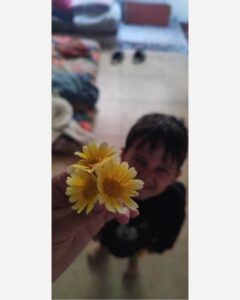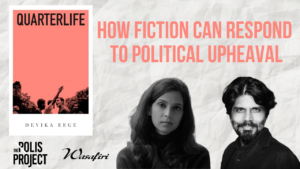
Breath, Labor, and Song: Artist Shilpa Mudbi on the Collective Cultural Resistance of Dalit-Bahujans
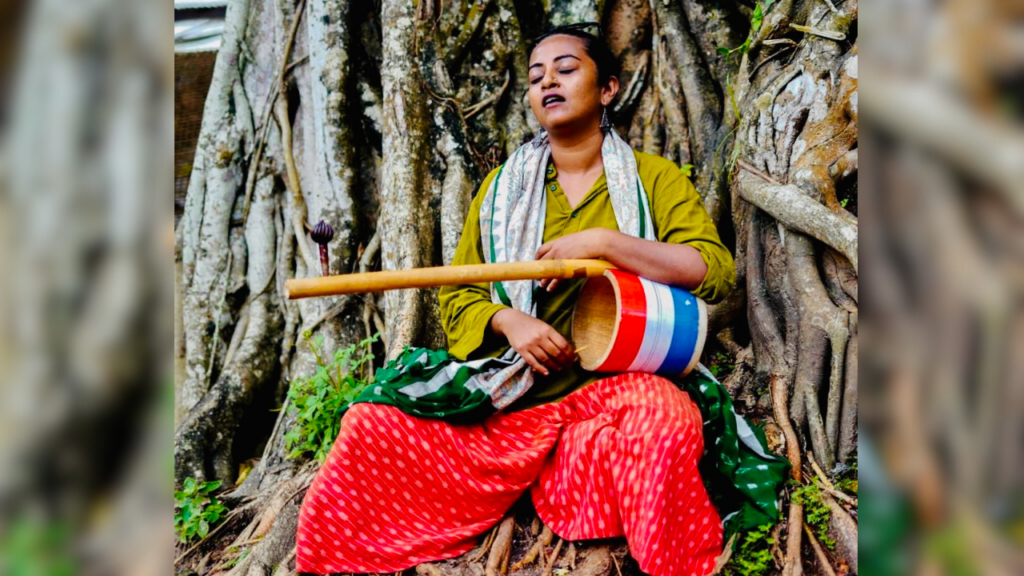
Collectivism emphasizes unity, selflessness, generosity, and community, where supporting one another and cooperating in a group is viewed as important. Dalit-Bahujan communities have long maintained collectivist cultures, and folk forms are proof. Creating folk art, including music, fosters cooperation over competition and empathy over discrimination. Art has been an integral part of Dalit-Bahujan lives for many centuries. They have produced art forms as a result of the collective experiences of their working bodies. Those experiences serve as a testament to their traditions, means of survival, cultural identity, and collective heritage.
In contrast, the art produced by dominant castes remains “chaste” to further caste supremacy. It doesn’t travel to communities beyond its own; when it does, it is bound by severe discipline that continuously tests the individual on the purity and perfection of their set rules— in raga (melody), shruti (pitch interval), aramandi (half-seated posture), and other aspects, for example.
Globally, communities subjected to colonization have stood their ground, collectively producing knowledge systems through human relationships. Although India is a broadly collectivistic country, Brahmanical culture has favored the market over relationships, and art is often appropriated from marginalized groups rather than appreciated and co-created by them.
A conversation with Shilpa Mudbi, an artist and folk researcher, explains how music produced by the Dalit community exudes collectivism. Owing to the absence of history in written forms for Dalit-Bahujan communities, folklore serves as evidence of centuries of the functioning of lowered caste communities amid oppressive conditions. Their histories are “symbolic, ideological, facts, and aspirations,” as Mudbi puts it.
Shilpa Mudbi’s Musical Journey
“As a Dalit-Bahujan woman who did her schooling in a convent school in Bangalore, I felt disconnected, and that confusion led me to be fascinated with folk,” she said in an interview with Eedina last month. “We couldn’t find the history of our community in any syllabus. I was understanding something that no other educational or commercial institution, or consumerist body, was telling me or teaching me. To understand my family’s culture, folklore became very important to me.”
For example, Mudbi had grown up watching performances of Yellamma in her village. “It’s a story of a woman who wanted to become a mother and stubbornly delivers a boy, who grows up to behead her,” she explained. “And metaphorically, you can see so many things play out in this story. Parashurama, who is the son, represents the Vedic culture. Now, if you look at the coastal region of Karnataka, it is Parashurama’s fief; he is the Ram of the coast, and Renuka Yellamma, on the other hand, becomes the underdog.”
When Mudbi was working with the theatre troupe ‘Indianostrum’ in Pondicherry, the director was developing a piece on the Sri Lankan civil war and asked the actors to “devise a deity who would come and take all the souls who died in war,” she recalled, a “maternal figure awaiting them on the other side, that is, the living world, to receive them.” She immediately thought of Yellamma and Matangi.
But Mudbi sensed gaps in her knowledge and began exploring different folk forms of Yellamma in North Karnataka, from Bellary to Bidar. Feeling overwhelmed by the richness and complexity of the story, she decided to leave Pondicherry and dedicate all her time to researching Yellamma. “I started narrating the story in English, it became a show, we put a set together,” she shared. “Jogathis blessed us with the instruments and would tutor us. And I took that as a challenge because I’d never seen these instruments.”
For nearly two years, Mudbi and her partner, Adithya Kothakota, sat in the Cubbon Park bandstand, narrating stories of Yellamma, regardless of who showed up. “It didn’t function like a class; we didn’t charge money, we just had the discipline to learn and practice,” she added. “So people poured in, about 300-400 must’ve shown up, regularly 10 people would come. If it rained and no one would come, just the dogs and we would perform for them too, and that was very calming.”
To Mudbi, the story of Yellamma is so widely carried on because “somewhere our identity is reflected in those stories. Folk formats and forms that have endured have done exactly that. They have allowed for this space to create collectively and feel pride in it collectively.” But she also holds collectivity in Bahujan identity as a result of shared pain. Collectiveness is “part and parcel of being on the outer rings of society, this is the only option for the people outside society,” she told me. Apart from being an element of shared pain, she also locates a similar jargon and varied life experiences in the process of creating art.
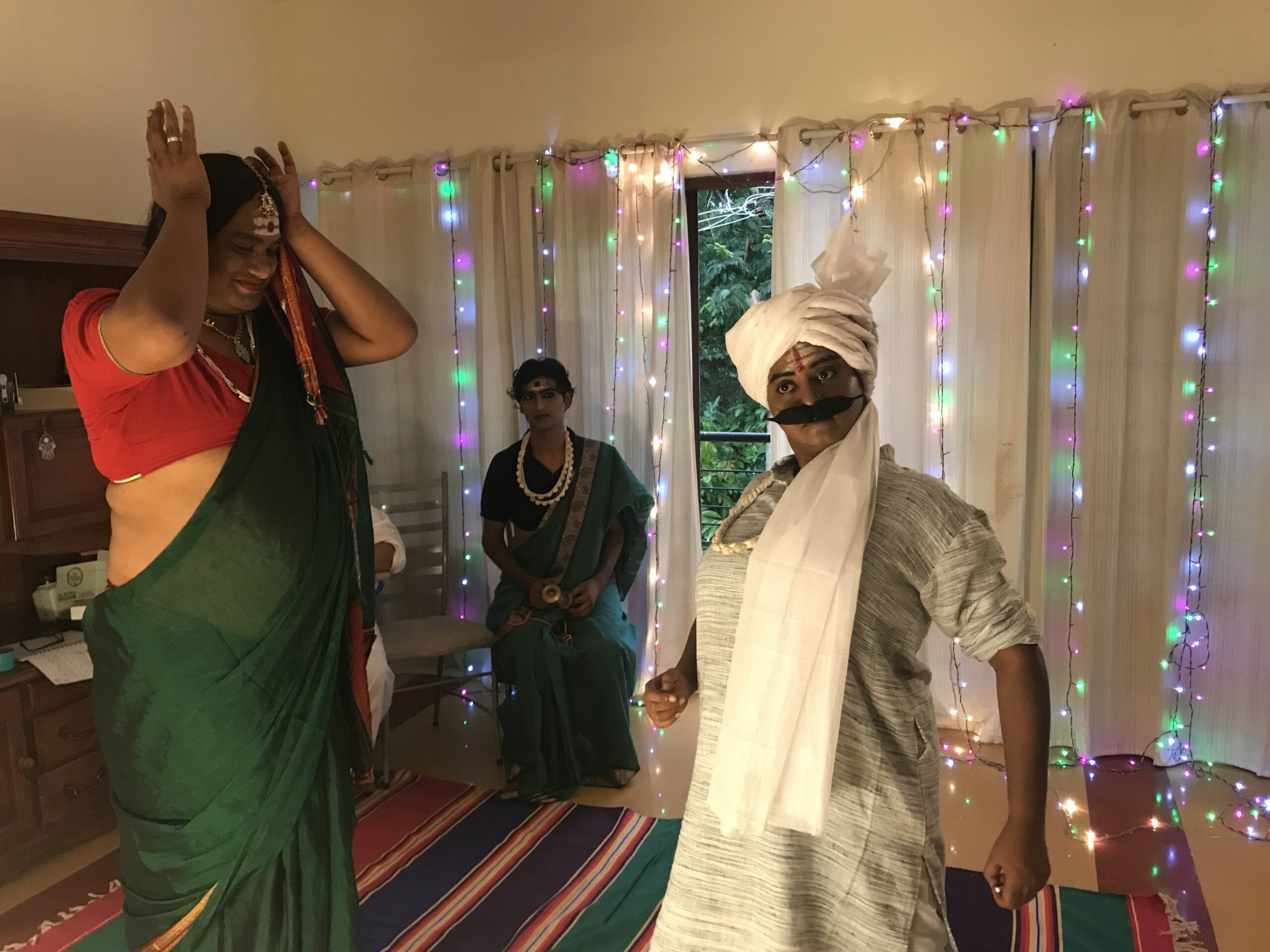
Folk Reflects Domesticities
For Dalit-Bahujan communities, domesticity and art are interwoven. Bahujans, who work primarily in agricultural fields for their livelihood, have collaboratively created a sustainable income from various pursuits. Whether it is planting paddy in the fields, sieving, pounding, winnowing and threshing grains, laying stones, reeling silk, or rearing livestock, most of their labor entails collective effort, which makes their everyday life a continuous process of cooperation. Additionally, domesticities like washing clothes by a river, cooking, feasting, and celebrating their deity or a festival, to name a few, foster a sense of community living.
All sorts of labor, where their bodies ached, have shaped their voice and action for so many decades that they also served as a backdrop for them to sing, dance, and make merry in their diverse lives. So, for Shilpa Mudbi, “work songs are not necessarily Madiga community songs or Holeya community songs, but they were working women’s songs, so of course reflected their lives. If not, they probably would not sing about their muscles hurting. But they are definitely singing about their environment and ecosystems around them, which have evolved so much.”
The Anatomy of Folk Voice
Where do certain sounds take root? Is it from the mouth, the throat, the stomach, or the entire body? With this wonderment, Mudbi highlighted how the breath of laboring bodies constitutes a Bahujan art form: in other words, how one’s breath defines the kind of work they are doing, which in turn constructs the voice.
Mudbi said, “You observe any old woman, the ones that have labored in agricultural fields — how they speak always relates to what that body has gone through. A working body breathes differently. Their voice has changed over time, according to how their bodies are working. If you listen to a working woman’s voice from Mangalore, and you compare it to a working woman’s voice from Bidar… just look at how different their voices are. It will relate to what kind of work they have been doing. How harsh the conditions are, what the landscape is doing to that voice— what altitude are you singing at, to what angle is your head tilted when you are singing? Are you singing towards the trees, the plants, towards the sea? What is the speed of the wind? All of these things are actually changing it.”
She added, “How you breathe has much to do with how you have grown up, what you are working, how much of your spine you are using, how much of your diaphragm you are expanding. Based on that, you will produce sound differently. Because your voice is your breath, your larynx, your voice box, your lungs, and the diaphragm underneath it. The entire top half of the body is being actively used, and the muscles connected to these parts are all over your body. If you can create that vibration that passes where your diaphragm is, and goes below— past your hips and knees— that is you using your entire body to sing.”
The voice that stems from laboring bodies carries emotions, cultural significance, caste and class, and ancestry. One of Mudbi’s teachers would say, “Being a theatre artist, you are supposed to sing a range where even the tip of your toe sings because it’s all muscles, it’s all connected.”
The folk voice is also an inheritance from the many caregivers around. The voice travels from one body to another, both genetically and through the experiences that the body has undergone. According to Mudbi, “you speak like how your mum speaks or your dad speaks, if not the accent, it’s within the breath, it’s in the slant, it’s in the tonality, how you end on a high pitch or a low pitch, all of these small things are being passed on to you only because you are learning your behavior from them.”
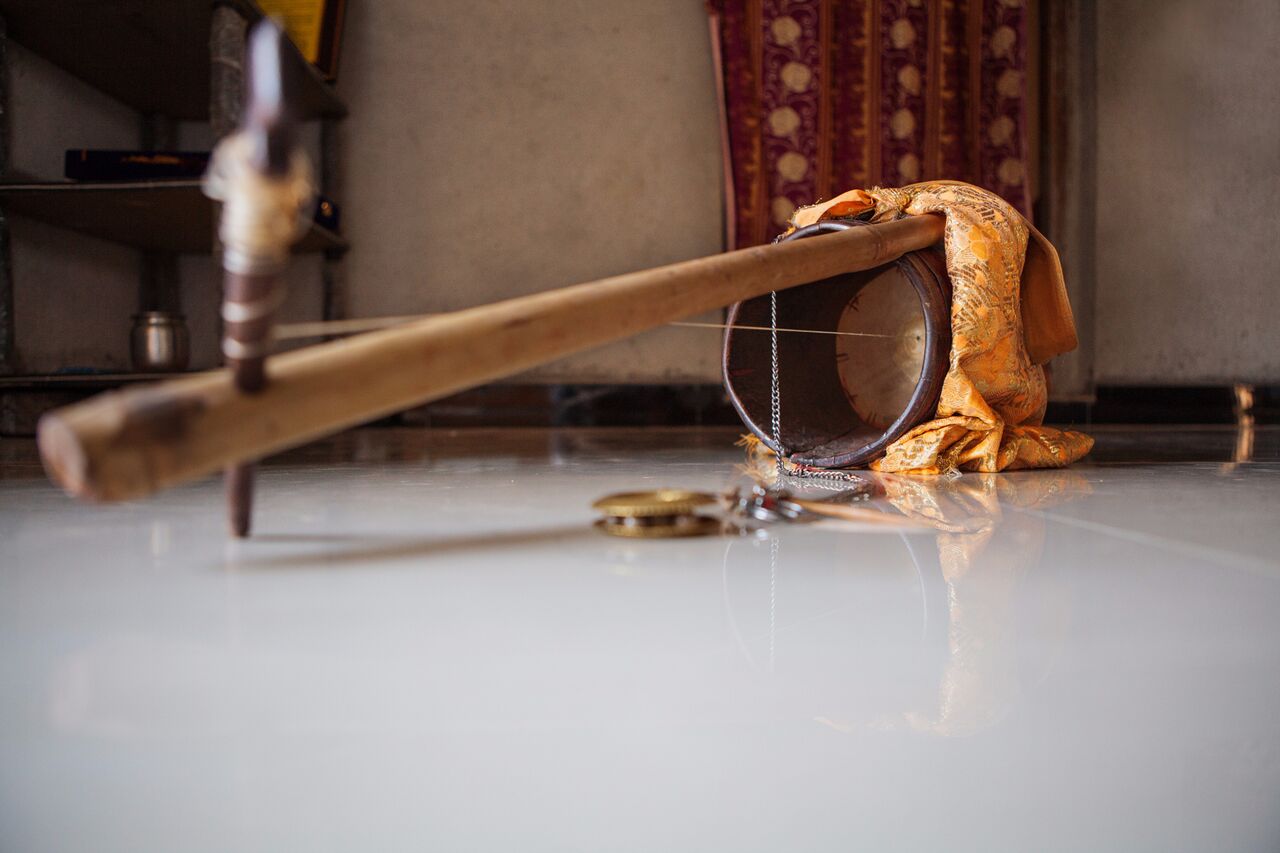
The Dawn of Sisterhood
Agricultural and other forms of labor, as well as domesticity, resulted in sisterhood among women, where they leaned on each other not only to complain about the repression but also as a result of their aching muscles. When everyday life revolves around the collective, the songs that the women weave are very much a non-romanticized version of the mundane.
Mudbi said, “Women who are working in agricultural fields and singing are weaving that song alongside the work. Even more importantly for me, they build the songs together. One is reacting to the story being told, they sing of livelihood…their songs talk about collectively lived strife. What is the livelihood of the daughter-in-law and the mother-in-law? What is it like to leave home? What would the situation be like when the brother returns from his village? Probably if their muscles hurt a lot, they spoke about happier instances. Very rarely do you see working women talking about birds and clouds….that is such a normal sight, that’s their backdrop. So they can’t romanticize it. So it’s mostly about their strife, but in a very nuanced way. They’re talking about their pain and wishing another woman well at the same time. They could use this as group therapy, share what happened: what did that landlord do? How do I kick that man?”
The defining feature of creating collectively is to nurture interpersonal relationships. With flourishing communal relationships, the space for authority and exploitation is progressively diminished and an environment of interdependence and healing is dawned. Thus, where Brahmanical art forms stand on the casteist and patriarchal guru-shishya parampara, folk art forms are molded on the structures of love and compassion.
As Mudbi put it, “We don’t learn directly from the guru; they are not teachers because they do not belong in that format. You put too much pressure by shoving them into strange boxes they do not know how to navigate. It all boils down to what kind of interpersonal relationships you had with each of the artists you’ve learned from, and how you continue to build those relationships. Everything is dependent on that relationship, and this is what is happening with me right now. If I do not have a great relationship with them, I do not have the confidence to practice their art. Unlike many other supposed famous voices who are upholding folk arts, they don’t give a damn if they are paying someone up.”
What Happens to the Collective when Brahmanism and Capital Enter?
Years ago, a not-so-well-known singer performed a folk song about the way of life of a specific community in Karnataka. The song was popularised, and the artist gained prominence for their transcendental vocals. Now, the problem with that popularity lies in the oppressor caste identity of the artist, the lack of caste experiences, obliviousness to the life of the community that collectively constructed the verses, singing in a non-folk voice, and lastly, doing so in a controversial place amid infamous personalities and getting praised by them. Therefore, culture is appropriated where it must be appreciated.
Mudbi said, “Generally, the market that has been created has been made competitive for folk artists — this field did not have this competition because it worked in the space of collaboration. But because it is the art of the voiceless, it’s constantly being hijacked by the government, upper castes, priestly class, institutions, advertisers, marketers, you name it…it’s a brand image-creating tool. It has been sort of a ‘done thing’ in the industry to take from folk, because folk belongs to everyone. The weight of it has turned it into a commodity. And however liberal they are, if they come from upper castes and more privileged positions, they do not want to [acknowledge their privilege], because of the credit they would be giving up.”
Brahmanical cultural hegemony weakens the collective in folk forms and strengthens the fixation on knowing everything and becoming the exclusive custodians of that information. Whether through Western imperialism or “caste-based colonization”, colonialism has consistently destroyed both the creative potential of the individual and the community, writes Brahma Prakash in ‘Cultural Labour: Conceptualizing the ‘Folk Performance’ in India.’
Mudbi said, “Commodification has changed the grammar of folk a lot faster because money has come in and they don’t get along, no folk artist will collaborate even if they are Jogathis.” She added that this competitive nature of the oppressor culture has transformed the collective essence of folk artists into an individualistic one to battle each other for capital.
When such art forms are introduced and adopted for the proscenium, the audience mainly encompasses city-bred, convent-educated, liberal-minded, art-understanding, oppressor-caste, and saviour-complexed savarnas. For Mudbi, by making folk an individualistic art, its reach and context are dwindling.
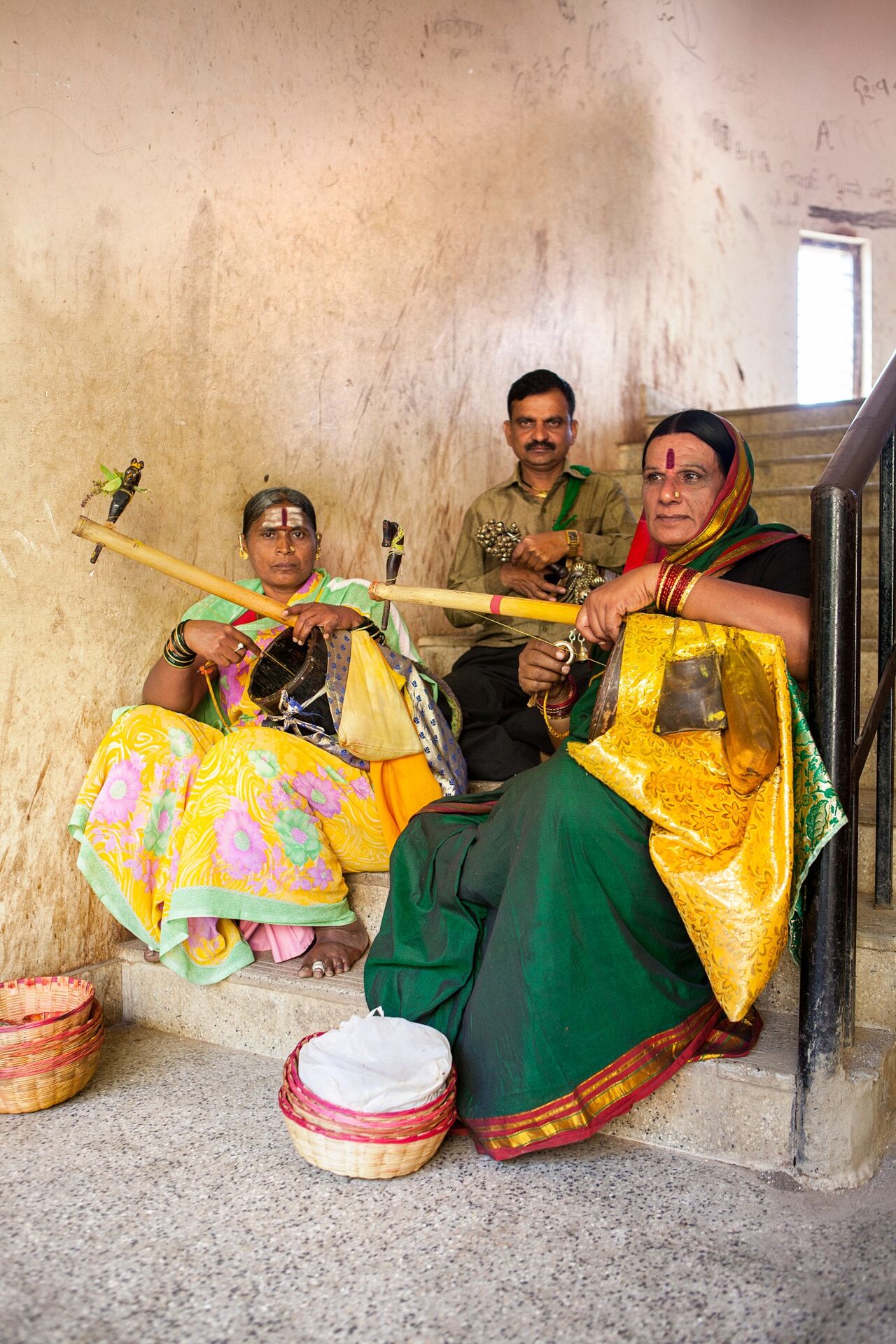
Re-Building the Community
“Even the poorest rungs of that [oppressor caste] have enjoyed a certain privilege of being part of the community for so many generations, that they will just not understand [how the oppressed castes feel],” said Mudbi.
“It becomes difficult for us to explain to them because we are also not in a position of power, and that is the main problem. We also don’t have institutions. Even as artists, there is this certain cultural brainwashing– or some kind of conditioning— that is happening to say that the priest class is always the poor class, and cultural capital is not capital, and folk is not relevant. To break that conditioning as Dalit artists is difficult. And because we speak about it, we will not be part of the mainstream circles, so maybe we need circles of our own, spaces where our own schools of imagination and thought can flourish. It is about creating space for ourselves and creating a certain movement.”



